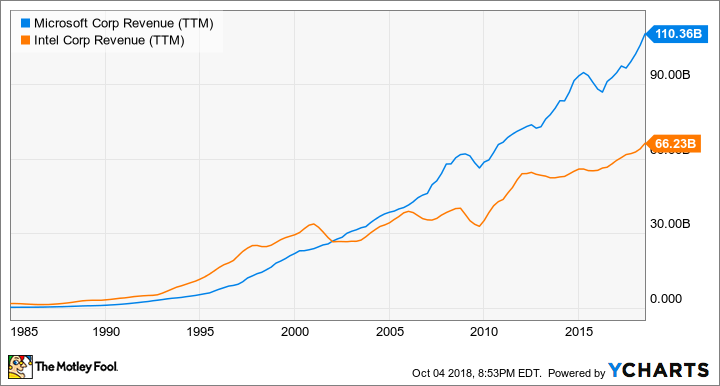Software giant Microsoft (MSFT -2.45%) and chip specialist Intel (INTC 1.77%) are practically synonymous with the personal-computer revolution. Microsoft built the Windows operating system, which has been and continues to be the dominant personal-computer operating system today, while Intel prevailed as the dominant supplier of chips into those systems.
Through the 90s and into the early 2000s, these two companies saw their values soar -- before, of course, their share prices came crashing back down to earth following the bursting of the dot-com bubble.
In the time since the dot-com bubble burst, though, Microsoft's shares have not only returned back to their previous bubble highs, but they've also blown right past them to hit new highs. And this time, the company's share price arguably far better reflects its fundamental business performance than it did almost 20 years ago.

Image source: Intel.
Although Intel is a large and profitable company, its share price has yet to return to -- let alone exceed -- its dot-com bubble highs.
Let's look at three ways Microsoft has outrun Intel.
The revenue picture
Over the past 12 months, Microsoft has generated $110.36 billion in revenue. Intel, by comparison, has taken in $66.23 billion in sales. Intel's revenue is by no means low -- it was the second-biggest chip maker by revenue behind memory giant Samsung in 2017, according to IC Insights, but Microsoft is clearly ahead here.
MSFT Revenue (TTM) data by YCharts.
There was a period until the early 2000s during which Intel generated more revenue than Microsoft did. However, in the years following that crossover point, Microsoft has simply left Intel in the dust.
Free cash flow and operating income
Both companies generate significant amounts of cash, but when it comes to free cash flow, it's not even a contest between the two -- Microsoft is far ahead and has been for many years.
MSFT Free Cash Flow (TTM) data by YCharts .
Over the past 12 months, Microsoft turned in almost $35.1 billion in operating income, while Intel generated nearly $20.5 billion. Although the gap between their respective operating incomes over the past 12 months isn't as large as the gap between their free cash flow generation over that same period, Microsoft still has a firm lead here.
MSFT Operating Income (TTM) data by YCharts.
Intel and Microsoft enjoyed similar operating margin percentages over the past 12 months, although Microsoft had a slight edge:
INTC Operating Margin (TTM) data by YCharts.
Market cap divergence
Microsoft brings in more free cash flow than Intel does, so it's not surprising that, these days, it's worth more than Intel is. The sheer size of the gap in market capitalization between the two tech giants, however, is noteworthy.
MSFT Market Cap data by YCharts.
Although Microsoft has been more valuable than Intel for a while, the gap between their market values has recently grown dramatically. Microsoft's market capitalization is nearly $866 billion, while Intel's is just shy of $222 billion.
MSFT Price to Free Cash Flow (TTM) data by YCharts.
Over the past 12 months, Microsoft has generated about 2.54 times the free cash flow Intel has. Microsoft's market capitalization, however, is about 3.9 times Intel's. What that suggests is that not only does Microsoft rake in more free cash flow than Intel does, but investors also look willing to pay more for each dollar of Microsoft's free cash flow than they are for Intel's. Put another way, Microsoft commands a higher price-to-free cash flow multiple than Intel does.
Investor takeaway
Microsoft looks like a more successful company than Intel is -- the former generates more revenue, throws off more free cash flow, and is more valuable than the latter.
On top of all that, over the past five years, Microsoft stock has simply delivered significantly greater appreciation than Intel stock.













